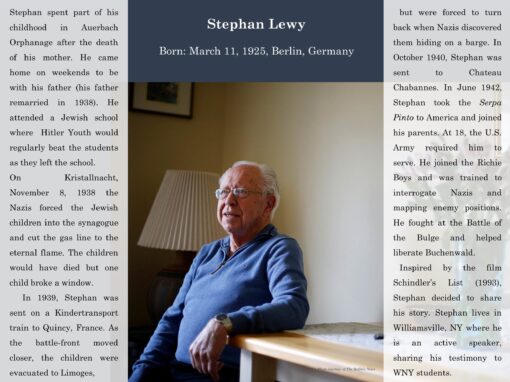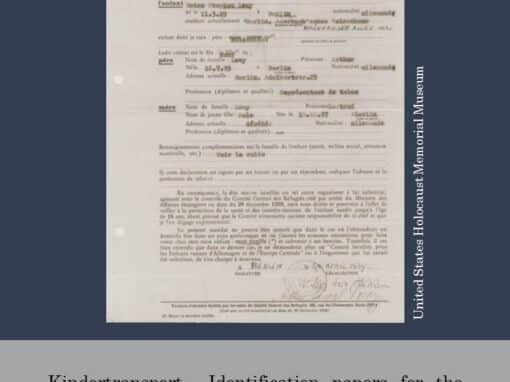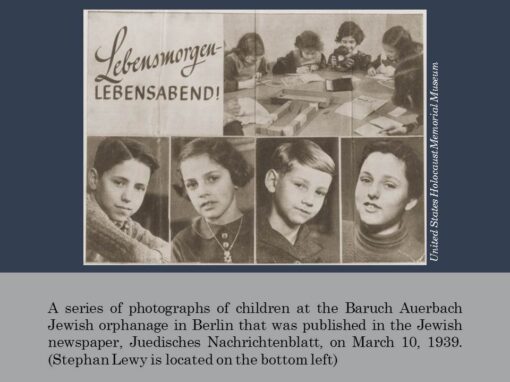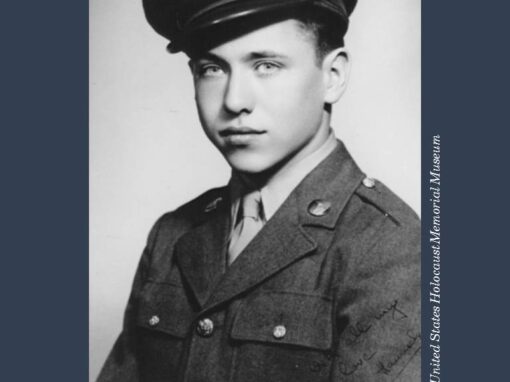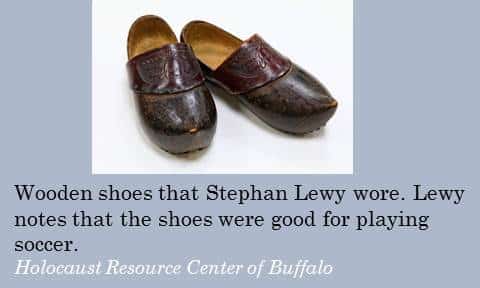Stephan Lewy
was born Heinz Stephan Lewy in Berlin in 1925. Stephan grew up in the Auerbach Orphanage where he lived through Kristallnacht hiding in the orphanage’s synagogue. Stephan was then sent on a Kindertransport to France in 1939, living in both occupied and unoccupied zones. In 1942, Stephan was able to get passage to the United States and in 1943 he was drafted into the U.S. Army. After the war Stephan returned to the U.S. where he still lives.
Stephan H. Lewy’s Biography
Pre-War Life
Stephan Lewy was born March 11, 1925 in Berlin to Gertrude Puls and Arthur Lewy. After a long illness, his mother, Gertrude, died in 1931 leaving Arthur to care for young Stephan. A year later, due to financial hardship, Stephan’s father was forced to place him in the Auerbach Orphanage, which cared for Jewish children like Stephan.
As the Nazis rose to power in the 1930s, conditions for Jews worsened. Suddenly, Stephan was not allowed to visit his father on Sundays because he had been taken to the Oranienburg concentration camp. Arthur was released from the camp in 1935, after having a heart attack which would not allow him to perform hard labor. Arthur had lost most of his teeth from beatings, his frame was slim, and his demeanor had changed significantly. The night of Stephan’s bar mitzvah, his father was arrested again and detained for most of the day. When he was released, Arthur warned him of the dangers that Stephan would face.
Kristallnacht
In the fall of 1938, Stephan’s father married Johanna Artzt, the sister of the woman who had been bringing Stephan home on Sundays. By this time, Arthur had lost his tobacco shop to Aryanization, a government policy that took Jewish property and redistributed it to non-Jews. At night Arthur collected tobacco orders from customers, for which he received a small commission, but he had to be careful because a birdcage in their apartment window would mean that there was a policeman waiting for him to come home.
The night of November 8, 1938, which would come to be known as Kristallnacht, the German government ordered an attack on all Jewish homes and businesses and the arrest of as many Jews as possible. The Auerbach Orphanage was not spared from this violence. Nazis broke into the orphanage, arrested all of the staff, then forced the children into the synagogue, where the gas line had been cut, and locked the doors behind them. Luckily, some of the older boys were able to break windows, which allowed the gas fumes to dissipate. The children were trapped in the synagogue until a neighborhood policeman let them out hours later. The next morning, the children were greeted by Nazi officials in their classrooms telling them that they were no longer welcome in the public school. A new allJewish school was established 40 minutes away and the children were regularly beaten with belts by Hitler Youth on their way to school, all while policemen watched to make sure that none of the Jewish children would fight back.
As Stephan told his parents about what had happened in the synagogue, they knew that they had to do something. The violence was not confined to Berlin; Jewish newspapers had been forced to shut down, Jews were being banned from certain professions, hundreds of synagogues had been destroyed, and thousands of Jews were being sent to concentration camps. Stephan’s parents decided that they had to leave Germany while it was still possible. Johanna had a cousin living in Boston whom she wrote to ask if he would sponsor the family so they could immigrate to the US. Acquiring a visa to travel to the United States required a medical exam, which Stephan’s father failed due to high blood pressure. This meant that all hopes of living under the same roof again were lost. However, Arthur and Johnna had another plan to ensure Stephan’s safety.
Kindertransport
Stephan’s parents knew that the Auerbach Orphanage offered a program, known as the Kindertransport, which could be Stephan’s ticket to a new life outside of Nazi Germany. Countries including France, England, and Denmark were accepting Jewish children from Germany as refugees. On July 4, 1939, Stephan, along with 40 other boys from the orphanage, boarded a train headed for France.
Stephan and the other boys arrived in Quincy-sous-Sénart, a small town about twenty miles south of Paris. They were going to be living in a chateau owned by Count Hubert Conquéré de Monbrison and his wife Princess Irina Paley, a cousin of the last Russian czar. The Count and his wife had opened their home to refugee girls from the Russian and Spanish civil wars years earlier, which is why the Oeuvre de Secours aux Enfants (OSE), a Paris-based Jewish children’s aid society, approached the couple about taking in the boys from Berlin.
On September 1, 1939, Germany invaded Poland, which then caused England and France to declare war on Germany. In May 1940, the Germans began invading France. One morning the boys woke to the sound of French soldiers setting up artillery in the courtyard. Count Monbrison arranged for passage for the boys to Limoges, a town 250 miles to the south. After four hours in the covered trucks, they had only traveled 6 miles due to the mass exodus out of Paris. One instructor arranged for the boys to board a barge that would take them further. The barge was soon stopped by the Nazis, who then discovered the boys hiding in the coal storage container, but took no further action. The instructors decided that it was best to leave the barge and walk back to Quincy, which was now 20 miles away.
Two days later, after being questioned by French police, caught in the line of fire between the French and Germans, and spending the night in a barn, the group arrived at Quincy. However, their chateau was not as they had left it. The French soldiers were gone and the Nazis had taken over their home. The commanding officer gave them two choices, be sent back to Germany, or stay and do chores.
In early October 1940, the boys were sent from Quincy to the town of Chabannes, which at that time was in unoccupied France. At the Chateau Chabannes, Stephan would begin to learn the art of leatherworking to better his chances of immigrating to another country. Life at Chabannes was much better and included music, sports, and education. As the Vichy government began to collaborate with the Nazis, life at the children’s home became dangerous. Luckily, Stephan had begun the search for his parents, who he discovered were now living in America. After gaining an American visa, boarding the Serpa Pinto in Casablanca, and escaping the Nazis once more, Stephan arrived in the United States on June 25, 1942.
Fighting the Nazis
On Stephan’s 18th birthday, he registered for the draft. Five months later, he began his training in the medical corps before being sent to a military intelligence training facility known as Camp Ritchie. Deployed overseas with the 6th Armored Division in Patton’s Third Army, Stephan regularly interrogated captured Nazis, created maps of enemy positions, and fought in the Battle of the Bulge. Stephan also helped to liberate the Buchenwald concentration camp and round up local Nazi leaders in Germany during the denazification process.
Life in the United States
After returning to the United States, Stephan obtained his high school diploma, enrolled in business classes at Northwestern University, and became a CPA. Along with working for two major hotel chains, Stephan got married and moved to Manchester, New Hampshire, where he and his wife Frances raised two children.
After retiring, Stephan returned to Berlin with a group of 88 other survivors and their families from around the world. Inspired by his trip and by the film Schindler’s List (1993), Stephan began to tell his story. Stephan lived in Williamsville, NY and continued until his death to speak to people about his experiences through the Holocaust Resource Center of Buffalo. “I have hope that I can make a difference…I hope that the world has learned a lesson.” – Stephan Lewy


